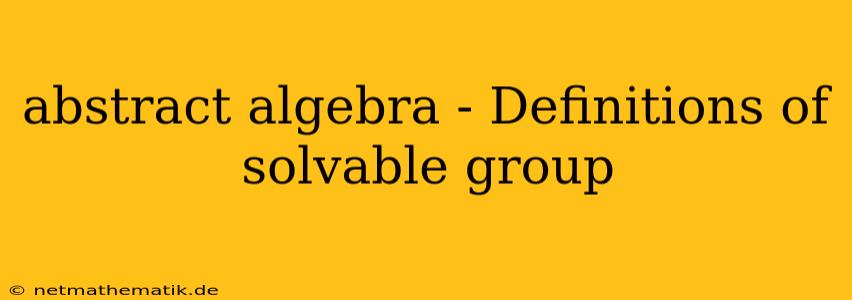Abstract algebra is a fundamental branch of mathematics that deals with algebraic structures, such as groups, rings, and fields. Within this realm, the concept of a solvable group is of paramount importance, holding profound implications for various areas of mathematics and its applications. Understanding the definitions of a solvable group requires delving into the intricacies of group theory, where the interplay of elements, operations, and their properties defines the very essence of these structures. This exploration unravels the meaning of solvability, providing a deeper understanding of the hierarchy within the world of groups.
Defining Solvable Groups: A Journey through Group Theory
The notion of a solvable group is intrinsically linked to the concept of a normal subgroup. In group theory, a normal subgroup is a subgroup that remains invariant under conjugation by any element of the group. This means that if H is a normal subgroup of G, then for any element g in G, the set gHg⁻¹ (obtained by conjugating every element of H by g) is equal to H itself.
Definition 1: Solvable Group via Normal Subgroups
A group G is called solvable if there exists a chain of subgroups
{e} = G0 ◁ G1 ◁ ... ◁ Gn = G
where each G<sub>i</sub> is a normal subgroup of G<sub>i+1</sub>, and each quotient group G<sub>i+1</sub>/G<sub>i</sub> is abelian.
Definition 2: Solvable Group via Derived Series
An alternative definition focuses on the derived series of a group. The derived series of a group G is a sequence of subgroups defined as follows:
- G<sup>(0)</sup> = G
- G<sup>(1)</sup> = [G, G] (the commutator subgroup of G)
- G<sup>(i+1)</sup> = [G<sup>(i)</sup>, G<sup>(i)</sup>] (the commutator subgroup of G<sup>(i)</sup>)
Definition 3: Solvable Group via Commutator Subgroup
A group G is solvable if its derived series eventually reaches the trivial subgroup {e}, i.e., there exists an integer k such that G<sup>(k)</sup> = {e}.
Unpacking the Definitions
These definitions may seem abstract at first glance, but their underlying meaning is crucial for understanding the structure of solvable groups.
-
Normal Subgroups: The requirement of normal subgroups in the first definition ensures a specific hierarchical structure. Each subgroup is contained within the next, forming a chain that progressively "builds up" to the entire group. This chain serves as a roadmap, guiding us through the internal structure of the group.
-
Abelian Quotient Groups: The condition that each quotient group G<sub>i+1</sub>/G<sub>i</sub> is abelian implies that the group is becoming increasingly "commutative" as we move up the chain. This is because abelian groups are characterized by the fact that their elements commute with each other (ab = ba for all elements a and b).
-
Derived Series and Commutator Subgroup: The derived series provides a systematic way to measure the "non-commutativity" of a group. The commutator subgroup [G, G] contains all elements of the form aba⁻¹b⁻¹, which essentially represent the "failure" of elements to commute. As we continue calculating the derived series, we essentially "extract" more and more of the non-commutative behavior of the group, eventually arriving at the trivial subgroup for solvable groups.
Importance of Solvable Groups
The concept of solvable groups has significant implications across various branches of mathematics and its applications.
-
Galois Theory: In Galois theory, solvable groups are directly related to the solvability of polynomial equations by radicals. This connection is fundamental to understanding the roots of polynomial equations and their algebraic properties.
-
Finite Group Theory: Solvable groups play a central role in the classification of finite groups. The structure of finite solvable groups is particularly well understood, allowing for detailed analysis and classification.
-
Coding Theory: Solvable groups are used in coding theory to construct efficient error-correcting codes. These codes can be used to transmit data reliably over noisy channels, ensuring that the original message can be accurately recovered even with errors introduced during transmission.
-
Lie Theory: Solvable groups also appear in Lie theory, a branch of mathematics dealing with continuous symmetries and their representation theory. This connection is particularly relevant in areas like quantum mechanics and physics, where symmetries play a fundamental role.
Conclusion
Understanding the definitions of solvable groups provides a foundational understanding of their significance and applications in mathematics and beyond. By exploring the role of normal subgroups, derived series, and commutator subgroups, we gain a deeper appreciation for the hierarchical structure of solvable groups and their connection to other important concepts in algebra. Their impact extends far beyond pure mathematics, influencing fields like cryptography, coding theory, and physics, showcasing the profound and enduring relevance of solvable groups in modern scientific endeavors.
